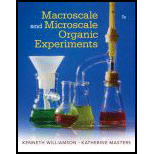
Macroscale and Microscale Organic Experiments
7th Edition
ISBN: 9781305577190
Author: Kenneth L. Williamson, Katherine M. Masters
Publisher: Brooks Cole
expand_more
expand_more
format_list_bulleted
Question
Chapter 8, Problem 5Q
Interpretation Introduction
Interpretation:
The expectations should be determined when the TLC plate is allowed to remain the chamber of development for long time, so that the solvent reaches at the top of the plate during analysis of mixture.
Concept introduction:
TLC works on the principle of separation of constituents of a mixture of compounds based on polarity. The polar compounds interact with the stationary phase thus can move to smaller distance from the base. While the non polar compounds tend to move faster as they interact less with the silica gel; therefore, they move far from the base of the plate.
Expert Solution & Answer
Trending nowThis is a popular solution!

Students have asked these similar questions
Explain why TLC cannot be used for some volatile low molecular weight substances such as
toluene.
A standard sample of compound A was placed on a silica TLC plate. After elution in 30/70 ethyl
acetate/hexane, the sample showed a single spot at 3.4 cm (relative to the initial point) after the
solvent had risen to 7.1 cm (relative to the initial point). A sample which was thought to contain
this compound was analyzed by TLC and showed two spots after elution in the same solvent
system. The solvent height for this plate was 6.5 cm (relative to the initial point) and the spots
were located at 3.6 cm and 5.2 cm (relative to the initial point). Can either of these spots possibly
be compound A? Explain.
Include a discussion of the R, for each spot.
IN GC, What effect does changing from a temperature ramp to an isothermal temperature program have on resolution of peaks at the beginning of the chromatogram versus the end of the chromatogram. Consider molecular weight and boiling point of the analytes.
Chapter 8 Solutions
Macroscale and Microscale Organic Experiments
Ch. 8 - Prob. 1QCh. 8 - Prob. 2QCh. 8 - What problem will ensue if the level of the...Ch. 8 - Prob. 4QCh. 8 - Prob. 5QCh. 8 - Arrange the following in order of increasing Rf...Ch. 8 - What will be the result of applying too much...Ch. 8 - Prob. 8QCh. 8 - Prob. 9QCh. 8 - A TLC plate showed two spots with Rf values of...
Knowledge Booster
Similar questions
- Consider a sample that is a mixture composed of biphenyl, benzoic acid, and benzyl alcohol. Predict the order of elution of the components in this mixture. Assume that the chromatography uses a silica column, and the solvent system is based on cyclohexane, with an increasing proportion of methylene chloride being added as a function of time.arrow_forwardDifferentiate between isocratic elution and gradient elution. Why is gradient elution sometimes a necessary technique in HPLC? What are the steps involved in gradient elution?arrow_forwardDifferentiate between gel filtration and gel permeation chromatography.arrow_forward
- At the completion of the experiment, a student measures the solvent front to be 55 mm from the baseline. If a component in the sample being analyzed generates a spot whose diameter spans from 34 to 36 mm from the baseline, calculate the Rf value for that component.arrow_forward2. What potential problem can a student have when an R₁ = 0 is obtained for an unknown sample on a silica TLC plate developed with a hexane mixture. How can this problem be avoided involving another TLC experiment?arrow_forwardIn color chromatography of plant pigments, what complications would a dried-out column (solvent level is below the top of the silica) introduce to the elution and isolation of pigments?arrow_forward
- What are the mechanisms of samples separation work in Thin layer Chromatography? Please shortly answer at your own words. Answer should be to the point (specific 4-5 lines).arrow_forwardWhat are the properties that determine retention time in the Chromatography process? Please shortly write at your own words. (5-6 lines maximum ).arrow_forwardAn orange compound, dissolved in dichloromethane, is added to a chromatogra- phy column. The elution is begun using hexane as the solvent. After 6 L of solvent was passed through the column, the orange band had still not traveled down the column appreciably. What should be done to make this experiment work better.arrow_forward
- If the TLC plates had been developed in a more polar solvent, would retention factors on the whole be larger, smaller, or unchanged? Briefly (1 - 2 sentences) explain your reasoningarrow_forwardExplain how it is that SPE cartridges & disks allow analysts to more efficiently pre- concentrate analytes from samples where they exist at low concentrations.arrow_forwardDescribe how to prepare adulterated palm oil samples before analysing it with Raman spectrometer. Also the describe the process how the Raman spectrometer will analyze the adulterated palm oil samplesarrow_forward
arrow_back_ios
SEE MORE QUESTIONS
arrow_forward_ios
Recommended textbooks for you
 Principles of Instrumental AnalysisChemistryISBN:9781305577213Author:Douglas A. Skoog, F. James Holler, Stanley R. CrouchPublisher:Cengage Learning
Principles of Instrumental AnalysisChemistryISBN:9781305577213Author:Douglas A. Skoog, F. James Holler, Stanley R. CrouchPublisher:Cengage Learning

Principles of Instrumental Analysis
Chemistry
ISBN:9781305577213
Author:Douglas A. Skoog, F. James Holler, Stanley R. Crouch
Publisher:Cengage Learning